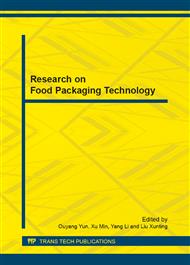p.3
p.7
p.13
p.17
p.21
p.26
p.30
p.36
Preparation and Property Study of Core-Shell Ambient-Temperature Crosslinkable Polyacrylate Binder
Abstract:
As the binder of waterborne inks, the capability of acrylic polymer has great influences on the quality of inks. In this contribution, structured latex particles with a poly (stryrene-butyl acrylate-methacrylate) core and a poly (butyl acrylate-methyl methacrylate-methacrylic acid-diacetone acrylamide (DAAM)) shell, which can be used as binders of water-based ink, were prepared by emulsion polymerization. The emulsion can cure in the course of film forming at ambient temperature through the reaction between DAAM and the adipic acid dihydrazide (ADH). Fourier transform infrared spectroscopy (FTIR), differential scanning calorimeter (DSC), transmission electron microscopy (TEM), atomic force microscopy (AFM) were used to characterize the structures and study the properties of the latices. The drying time of the crosslinking latices was investigated. In addition, influences of DAAM monomer dosage and the mole ratio of DAAM to ADH on the mechanical properties of self-crosslinkable core-shell latices were also discussed. It was found that the core-shell crosslinkable particles with a low glass transition temperature (Tg) core and a high Tg shell have better film properties and would be more applicable to binders of water-based ink for plastic film, in comparison with those particles with a high Tg core and a low Tg shell.
Info:
Periodical:
Pages:
3-6
Citation:
Online since:
November 2013
Authors:
Price:
Сopyright:
© 2014 Trans Tech Publications Ltd. All Rights Reserved
Share:
Citation:


